Help Center
Curtains Guide
How to Choose for Curtains?
By Curtain Types
Choosing the right curtains can significantly transform a space, bringing a softer, more comfortable ambiance to your living environment.
Designer
Featuring unique textures and a sense of design, our curtains range from adding elegance and comfort to transforming spaces with creative effects. Each curtain meets diverse needs and tastes, adding comfort, warmth, and personality to your space.
Foil Printed Velvet
Foil-printed velvet curtains combine the opulence of velvet with the sophistication of hot-stamped foil designs. This process imprints unique, eye-catching prints onto the luxurious velvet fabric, creating a striking interplay of texture and shine. The result is a collection of curtains that offer both rich tactile depth and a visually stunning, metallic finish.
Sheer Curtains
Sheer curtains, made from transparent and lightweight materials, serve as excellent light filters. Their flowing beauty and functional benefits enhance the atmosphere of any room while offering a stylish complement to various settings.
Textured Curtains
The intricate weaves and patterns offer a tactile quality that enhances both visual appeal and overall ambiance. Ideal for adding a touch of grandeur and sophistication, these textured curtains elevate the decor with their elegant and luxurious finish.
Solid Curtains
Custom solid-colored curtains, available in an extensive palette of hues, offer the perfect foundation to enhance your decor with a timeless, minimalist charm. Whether you aim for a bold statement or a subtle accent, these curtains are precisely tailored to your dimensions for a flawless fit. Their durable construction and versatile styling make them a seamless addition to any space, adding warmth, texture, and elegance. Perfect for bedrooms, living rooms, or offices, these curtains effortl essly blend style and functionality, offering a personalized touch to your interiors.
By Curtain Fabrics
Linen
Transform your home with our custom linen curtains, where rich texture meets rustic elegance. The natural weave of linen infuses timeless charm, bringing warmth and sophistication to any room. These durable, stylish curtains seamlessly combine form and function, enhancing your space with their organic beauty. Discover the perfect linen curtains to complement your decor and elevate your home's ambiance effortlessly.
Velvet
Immerse yourself in the luxurious allure of our custom velvet curtains, where richness and elegance harmoniously unite. The sumptuous texture of velvet brings a refined sophistication to any space, fostering a warm and inviting ambiance. These curtains not only elevate your decor with their opulent appearance but also offer superior light control and insulation. Explore our collection to discover the perfect velvet curtains that seamlessly combine style and practicality, enhancing your home's atmosphere with effortless elegance.
Wool
Featuring unique textures and a sense of design, our curtains range from adding elegance and comfort to transforming spaces with creative effects. Each curtain meets diverse needs and tastes, adding comfort, warmth, and personality to your space.
Cotton
Transform your home with our custom cotton blend curtains, where comfort and versatility come together. The soft, breathable texture of cotton creates a light, airy atmosphere, making any room feel more inviting. Renowned for their durability and ease of care, these curtains are ideal for various settings. The cotton blend delivers a natural, laid-back aesthetic, infusing your decor with a subtle elegance. Discover the timeless beauty and exceptional quality of our cotton blend curtains, expertly crafted to enhance and elevate any living space.
Synthetic
Discover our collection of custom curtains made from synthetic fibers, celebrated for their durability and low-maintenance qualities. Designed to withstand the rigors of everyday use, these curtains are an ideal choice for any room in your home. The synthetic fabric is easy to clean and resistant to fading, ensuring your curtains maintain their vibrant look for years. Available in a wide range of styles and colors, our synthetic curtains blend practicality with aesthetic appeal, offering a hassle-free solution without compromising on quality or design.
By Curtain Functions
Soundproof Curtains
4 - Layer Soundproof Fabric
Depending on the fabric and lining, these curtains can block 15-20 dB of sound.
Fire Retardant
Our fire-retardant curtains have been NFPA701 certified (certificate link). It is designed to stop burning right after the source has been removed to prevent dangerous situations. You can choose accordingly based on functional needs and compliance with fire safety regulations.
By Curtain Light Control
Curtains have the ability to regulate light, with different types catering to various lighting needs. Sheer and light-filtering styles allow sunlight to pass through and can be layered to enhance a cozy atmosphere, while blackout curtains add privacy and a touch of style, creating a more secluded and serene space.
Sheer Curtains
Allows maximum light to pass through while still providing minimal privacy.
Light Filtering Curtains
Light filtering curtains evenly diffuse light throughout the room, creating a soft, warm glow.
Blackout Curtains
Unlined Blackout Curtains
Fabrics like Quinn, Victoria, Florence, and Kensington effectively block out light when unlined, achieving 100% darkness in your space. This creates a more comfortable sleep environment, helping you rest better. Explore our extensive selection of blackout curtains for more options.
Soundproof Blackout Curtains
Each blackout soundproof curtain is equipped with a built-in soundproof layer that effectively reduces external noise, creating a serene environment for relaxation or concentration. Choose from our wide array of colors and fabrics to find the perfect combination of functionality and style for your home.
Note: Unlined fabrics itself can achieve varying levels of light control
For a tactile experience of texture and color, we offer fabric swatches for you to choose from.
Light Filtration Calculator
How to Measure for Curtains?
How to measure for panel width?
Panel Width=Rod Width x Fullness ratio ÷ Number of Panels
Rod Width = A + B + C
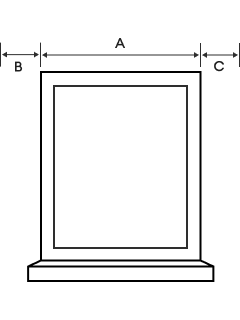
However, please also consider the following:
Available space: These recommendations assume there is enough room above and beside the window. If space is limited, the rod placement may need to be adjusted accordingly.
Finial space: When selecting your rod length, keep in mind that the decorative finials on both ends will also take up space. The listed rod length typically does not include the length of the finials.
Fullness Ratio
Curtain fullness refers to how much wider the fabric is compared to the curtain rod or track, influencing how pleated or gathered the curtains look when closed.
Recommended fullness ratios vary by header style:
Grommet Header
1.5x-1.8x fullness
Soft Top Header Styles
Back Tab & Rod Pocket
Single Rod Pocket
The recommended fullness ratio vary depending on the number of layers and the thickness of the curtain fabric:
1.8x-2x for sheer curtains
1.5x for single/double layer blackout curtains
1.2x for 4-layer soundproof curtains
Pleated Header Styles
1.1x fullness
Double/Triple French Pinch Pleat
Inverted Box Pleat
Goblet Pleat
Euro Pleat
We suggest selecting the finished width at a 1.1x ratio, as the curtain already includes 2.0-2.3x fullness sewn into the pleats.
4-Prong Pleat Hook & Clip Rings
1.5x-1.8x
How to Select Curtain Linings?
Lining Fabric: Refers to the material applied to the back of the curtain.
Purpose: The lining enhances the functionality of the curtains, adding a refined drape. It also allows for better control over light filtration, blocks sunlight, reduces noise, and provides insulation, helping to retain heat in winter or keep the space cooler in summer. In addition, it boosts the overall performance and energy efficiency of the curtains.
Privacy Liner : Liner itself blocks 30-50% of light
Blackout : Provides 100% blackout - no light coming through
Soft Low Density Liner : Liner itself blocks 60-80% light
What is Curtain Memory Training?
Through careful steaming, pressing, and shaping, memory treatment helps the fabric hold its form, enhancing the overall aesthetic of the room while ensuring a consistent polished look over time.
This is crucial because it helps the fabric retain a uniform and structured appearance, ensuring that pleats or folds stay perfectly in place. By organizing the drape, you can achieve a more refined, graceful look with minimal effort over time.
Curtain Rod and Curtain Tracks
Curtain Rods
Customizable Fixed Length Curtain Rod
Curtain rods are one of the most used curtain hardware pieces, designed to be placed at the top of the window to hang curtains fixed on adjustable metal brackets.
Curtain rods are primarily designed for short to medium distances. They can be used for wider spans and require more brackets for support.
Max Load: 10-24 KG
Adjustable Curtain Rod
Adjustable curtain rods are used for lightweight to medium-weight curtains.
They feature a sliding system that allows the rod to extend and retract. This system enables you to set the exact length of the rod, adjusting it within a specified maximum and minimum size range, making it suitable for cost-effective and practical scenarios.
Max Load: 7-10kg/m
Curtain Tracks
DIY Adjustable Tracks
Flexible in application, lightweight and easy to install, with customizable track length. Made of durable PVC, plastic curtain tracks are generally more flexible than metal, making them ideal for bay windows, especially curved ones.
Max Load: 7-10kg/m
Heavy Duty Metal Custom Tracks
Designed to prevent curtains from getting stuck in the track, these are ideal for tall windows. Most come with a Teflon coating to ensure smooth and quiet operation.
Max Load: 22-45kg/m
Weight Capacity of Curtain Rods and Curtain Tracks
Lighter curtains work well with both curtain rods and tracks, but for heavier curtains, it's best to consider using a track with a pull handle for easier operation.
Using a track also helps prevent curtains from getting stuck and is ideal for tall windows.
Choosing the Correct Installation Position
For bedrooms or spaces where light control is important, curtain tracks paired with blackout curtains are the best choice. These tracks can be easily installed within the window recess, allowing the curtains to completely block out the light from the entire window.
Curtain Weight Calculator
Door Curtains Guide
How to choose for door curtains?
Our insulating door curtains are made to enhance your home's comfort and efficiency. Experience better temperature control, reduced drafts, and lower energy costs with high-quality, thermal insulating materials. These curtains offer effective coverage and stylish designs, ensuring you stay cozy in winter and cool in summer. Elevate your home's ambiance and functionality with our versatile insulating door curtains
How to measure for door curtains?
Please carefully measure your door dimensions (excluding the door frame) before selecting the appropriate curtain size.
The exact curtain size should be 2 inches wider and 2 inches taller than your door to ensure a proper fit within the door frame.
Sun Shade Sail Guide
How to Measure Shade Sails
Make sure you are measuring from mounting point to mounting point, and not just measuring the area on the ground. It might help to determine and note down the height of each of your mounting points from the ground up, especially if you wish to anchor the shade sail onto walls.
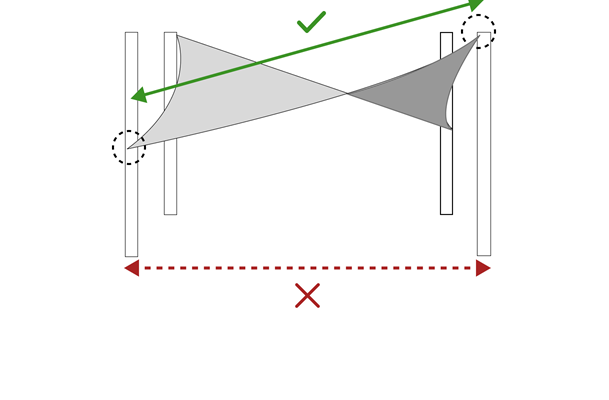
Different shaped shade sail requires different measurements to be taken
Triangular: 3 sides
Rectangular: 4 sides & two diagonal
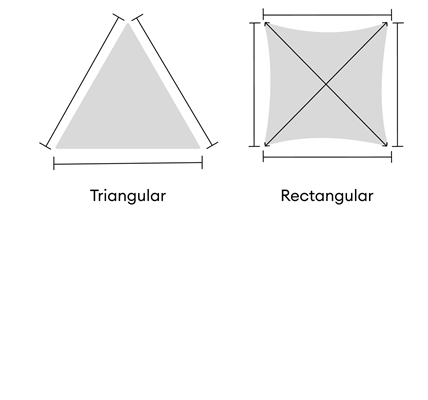
We recommend measuring from anchor point to anchor point. Based on the numbers you provide we'll deduct 20 inches on the either the longest side or the longer diagonal (depending on which shade sail it is - specified on product page) while maintaining the shape to ensure a stable attachment, proper tension and minimize sagging.
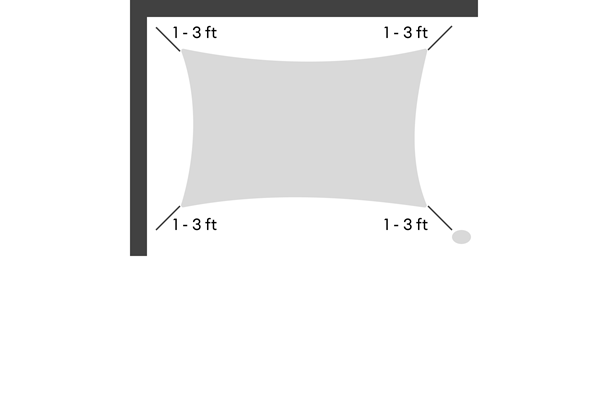
If you wish to cover a large area try combining several pieces of shade sails together.
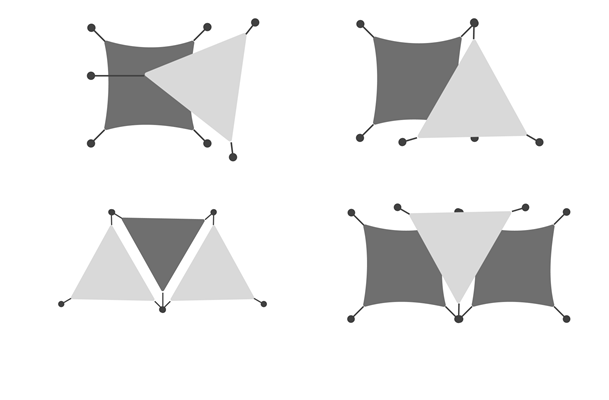
Installing the Shade Sails
Place pad eye onto the determined mounting point and mark the four holes.
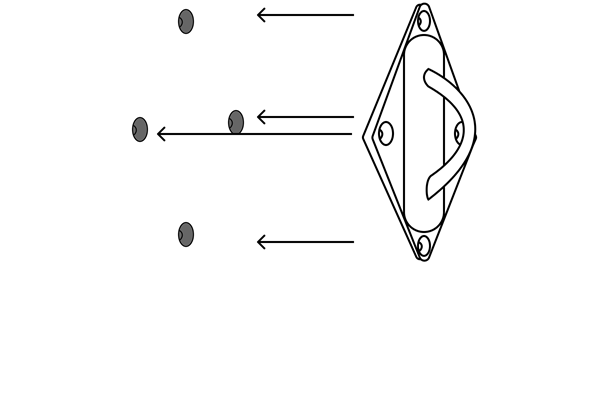
Use the corresponding sized drill bit to drill into marked points and insert expansion inserts a. (e.g. M6 requires 6-mm diameter drill bit)
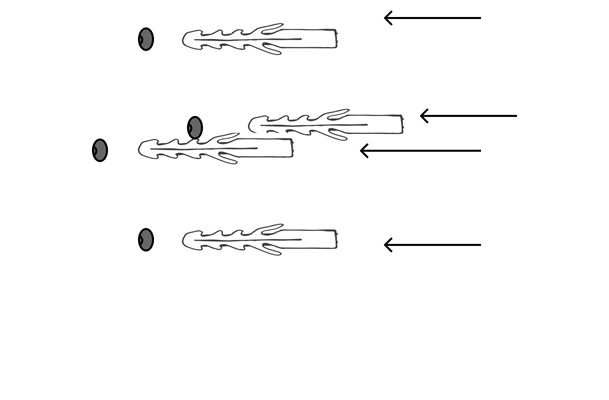
Place pad eye back on and secure with nails
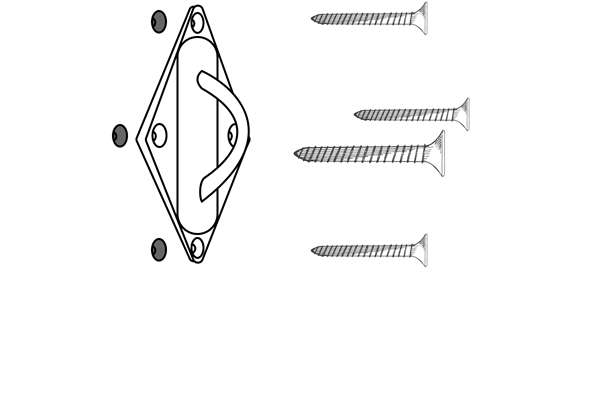
Install snap hook or adjustable turnbuckles as needed and make sure the tension of the shade sail surface is correctly distributed. The shade sail should be flat and evenly stretched out in all directions.
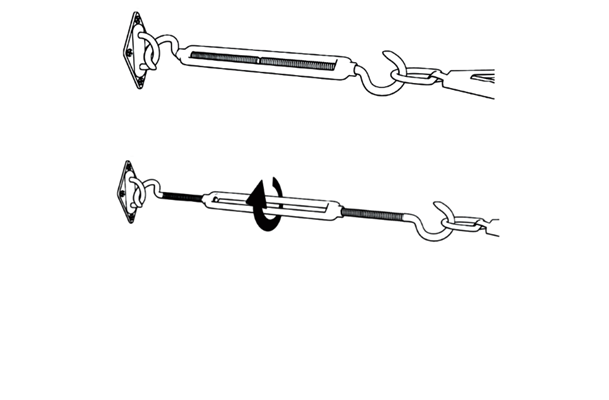
Ensure the mounting point direction is a continuation on the diagonal of the shade sail surface for even tension distribution.
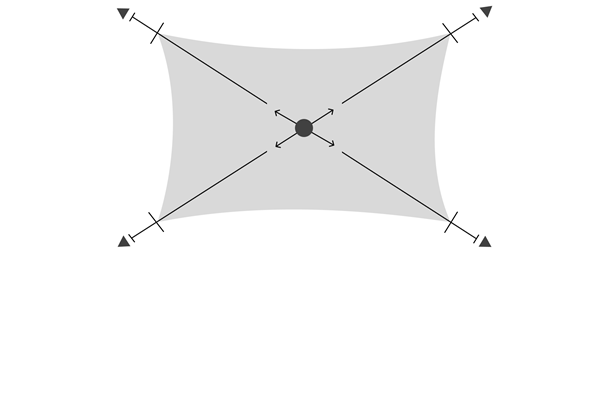
Make sure the shade sails are installed at least 40 degree angle so that water can drain smoothly to prevent pooling
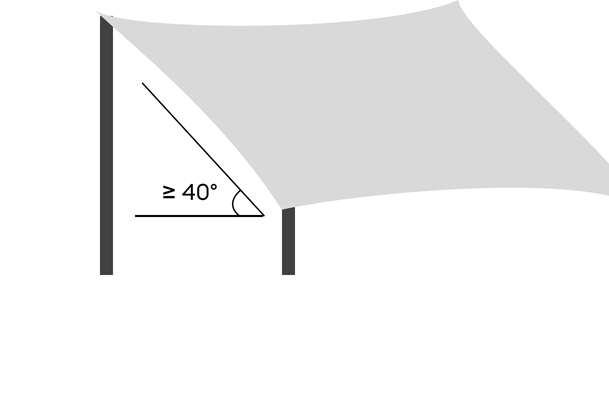
All corners of the shade sail need to be fully stretched out and evenly distributed
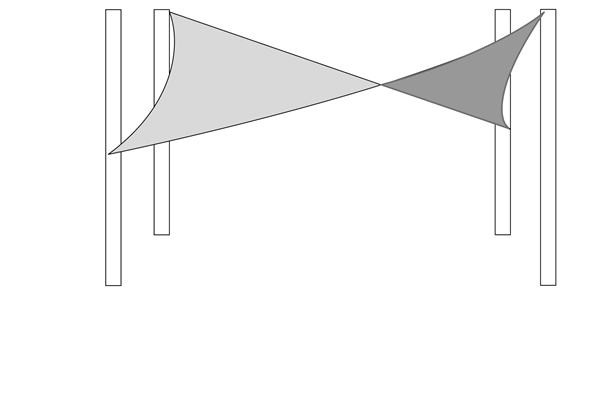
Apart from hardware installation kit and ropes we also offer support pole and ring clip that can be used to secure shade sails
The pole is secured at the base with four pieces of expansion nails
Install the ring buckle where you wish the mounting point to be and use with snap hook or turnbuckles to secure your shade
Roman Shades
Roman Shade Styles
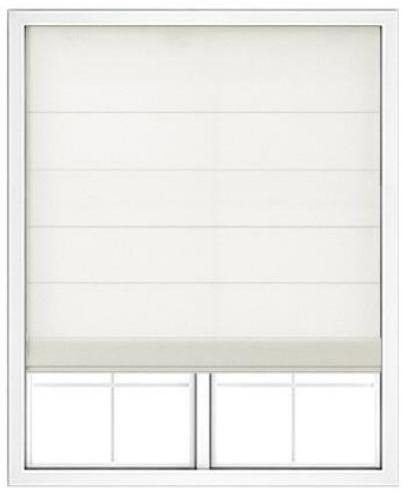
Plain Fold

Flat
Single-layer and sheer fabric constructions are not supported.
Sheer fabric construction is not supported.
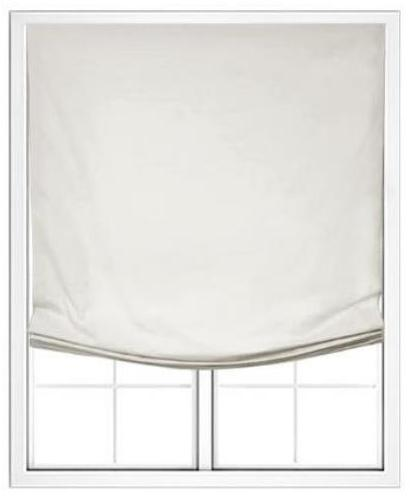
Relaxed
Sheer Shades are unlined
Please Note: If the production size you need exceeds the limit value on product page, contact customer service at support@thehues.com for consultation
Control & Lift Styles
| Control Options | Lift Styles | Plain Fold | Flat | Relaxed |
|---|---|---|---|---|
| Cordless |

Waterfall Lift Control 
Adjustable rod dimensions range from 28" to 53" |
✓ | ✓ | ✘ |
| Motorized |

Waterfall Lift Control |
✓ | ✓ | ✓ |
Lining Options
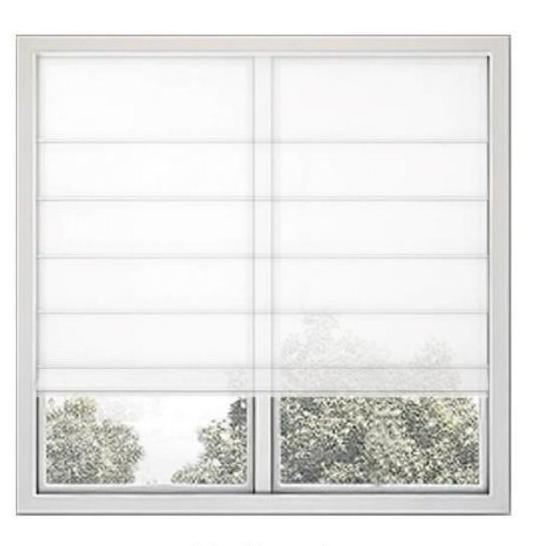
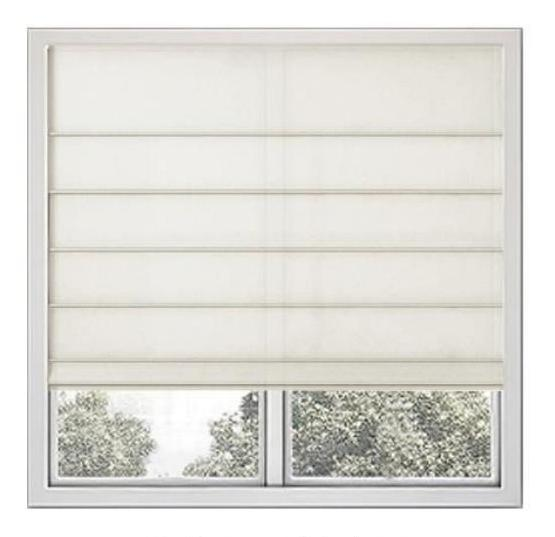
Provides privacy while still lets light in
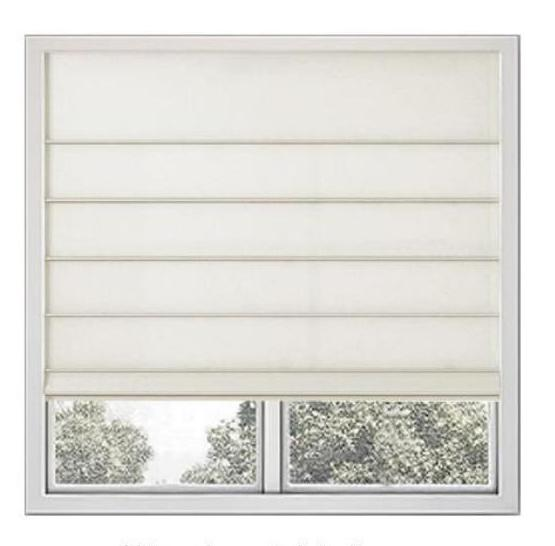
Blocks up to 95% of light for privacy and thermal insulation
Motorization & Remote Control

How To Measure - Inside Mount Roman Shades
Measure each window individually, even if they appear identical. Use a metal tape measure and round down to the nearest 1/8 inch. Record all measurements on a measurement sheet.

1. Measure Width
Since windows are not always perfectly square, we recommend measuring the width in three places - top, middle, and bottom (① & ② & ③).
Round all measurements to the nearest 1/8”. Use the smallest of the three as the final width for your order.
We will make a 1/4” deduction (1/8” on each side) to ensure a proper fit and better shading.
2. Measure Height
When measuring the height, take three measurements - positions ④ & ⑤ & ⑥.
Round each to the nearest 1/8”. Use the largest of the three as the final height for your order.
3. Measure Window Depth
Measure the depth of the window frame to ensure there is enough space for a secure inside mount.
Be sure to note any obstructions, such as handles or tracks, that may affect the shade's functionality.
Measure the distance from the obstruction to the edge of the window frame and use that measurement.
Roman shades require a minimum depth of 1 3/4” for inside mounting.
How To Measure - Outside Mount Roman Shades
Measure each window individually, even if they appear the same.
Use a metal tape measure, round down to the nearest 1/8”, and record the measurements on a measurement sheet.

1. MEASURE WIDTH
Measure the exact width of the area you want to cover.
2. MEASURE HEIGHT
Measure the exact height you want to cover, including any desired overlap.
It's recommended to leave at least 2” above the window to accommodate the headrail and brackets.
At this stage, consider the stacking height of the shade when fully raised.
This measurement will be the height of your order.
Dividing A Window Into Multiple Roman Shades

If a window is particularly wide or the width of the Roman shade exceeds the maximum production limit, we can divide the shade into multiple sections.
This approach can enhance both functionality and aesthetics and is typically done by aligning the divisions with the window mullions.
Curtain Fabric
Liner Fabric
*Click "+" button to add fabric
Cutain Fabric: {Fabric} Total of {shading}% light blocked with the selected curtain Light filtration level: {liner}
Choose Your Curtain Fabric
Single Layer Curtains
4 Layer Curtains
Choose Your Liner Fabric
Unlined
Privacy
Soft Flat Finish Lining
Thick Satin Finish Lining
100% Blackout
Same fabric liner
Greyish White Liner
Black Liner
Comparable Color Liner
Same fabric liner

Curtain Fabric
Liner Fabric
*Click "+" button to add fabric
Choose Your Curtain Fabric
Single Layer Curtains
4 Layer Curtains
Choose Your Liner Fabric
Unlined
Privacy
Soft Flat Finish Lining
Thick Satin Finish Lining
100% Blackout
Same fabric liner
Greyish White Liner
Black Liner
Comparable Color Liner
Same fabric liner